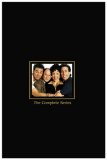| Reviews & Columns |
|
Reviews DVD TV on DVD Blu-ray 4K UHD International DVDs In Theaters Reviews by Studio Video Games Features Collector Series DVDs Easter Egg Database Interviews DVD Talk Radio Feature Articles Columns Anime Talk DVD Savant Horror DVDs The M.O.D. Squad Art House HD Talk Silent DVD
|
DVD Talk Forum |
|
|
| Resources |
|
DVD Price Search Customer Service #'s RCE Info Links |
|
Columns
|
|
|
Seinfeld - The Complete Series
THE SHOW:
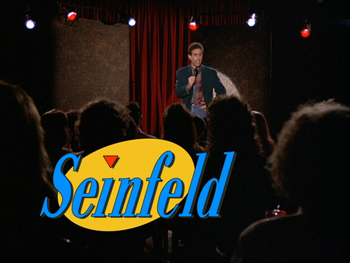
I grew up on the television of the 1970s and '80s and loved a whole hell of a lot of it back then. Let's be honest, though, when one looks back at those decades, the vast majority of the series that were popular haven't aged all that well. The drama is hackneyed and over simplified, and the sitcoms rely on hokey jokes and recycled ideas. Perhaps the golden age of television, of personalities like Lucille Ball and Dick Van Dyke and Sid Caesar, loomed so large, producers felt like they could only chase after what had already passed, never quite catching up to it. The little brother who wants to play along but can't manage to keep up with his older sibling due to his stubby little legs. In a lot of ways, the introduction of color spelled the death of the first wave of classic television the way the introduction of sound was expected to kill motion pictures. While a few series survived the transition, much of what endures, at least for me, was shot in gorgeous black-and-white.
It wasn't until the 1990s that television began to move into a whole new era of quality. A lot of this had to do with cable TV and new networks upping the ante. Increased competition meant the people actually making these shows had to try harder to stand out from the pack. I also think there was an influx of people who, like myself, had grown up nurtured by the glow of the glass teat, people who truly loved TV with such force that they wanted to be a part of it but also saw the errors of its ways. People like Larry David, who saw the potential in the sitcom format and jumped into the fray with the intention of fixing the things that had always bugged him about TV shows. He speaks about it a little on the bonus features on the DVDs collected in Seinfeld - The Complete Series. He and Jerry Seinfeld wanted to bust conventions, to do something different; in short, to be themselves.
Of course, as we all know, they succeeded, and Seinfeld became one of the most influential series ever beamed over the airwaves. Running nine seasons, it pushed all the boundaries, from how the stories were told to testing the strength of accepted taboos. Before Seinfeld, would anyone have dared talk about masturbation or feminine hygiene products on a network sitcom? Was anyone ever killed off for comic effect on Three's Company or Too Close for Comfort? Not bloody likely! Those would require "very special episodes." Such notions were ushered out by Seinfeld. Instead, what we got was adult humor, caustic sentiment, and none-too-gentle elbows poked into the awkwardness of modern living. Seinfeld made it okay to be a little mean, and by being mean, to be more honest. In the characters of George, Jerry, Elaine, and even Kramer, we were able to let fly with all the things that weren't necessarily acceptable in everyday life. They were our avatars, the ones who were "just saying what we're all thinking." Granted, they took it farther than any of us ever would, even if given the space to cut loose, but that's what made it so damn funny. Like a fun-house mirror, it took all of our private anxieties and blew them up to a gargantuan public spectacle.
The core cast of the show remained constant for all nine seasons, and the construction of the team was such that the show couldn't have functioned without any one of them missing for any extended length of time (in fact, after "The Pen" in Season 3, there was never another show where any of the main quartet was missing, barring Julia Louis-Dreyfus' maternity leave). They were like the Beatles of comedy, where every person served the right function and the resulting chemistry was new and exciting; also like the Beatles, they've all struggled to match past accomplishments in the solo careers that followed. It was Jerry (played, obviously, by Seinfeld), the neurotic comedian who served as the axis for the others; George (Jason Alexander), the cheap, petty, and horny screw-up and a stand-in for Larry David; Elaine (Louis-Dreyfus), the lone female in the group, judgmental and prone to be a little frightening in her fury, both a girl and just one of the guys; and the wild card, Kramer (Michael Richards), the rubber-limbed "hipster doofus" who was liable to say or do anything.
These four were the unrepeatable formula. They were what made Seinfeld a comedy institution, fearless in their rejection of any conventional ploys to be liked. The motto of the show: "No hugs, no learning." Seinfeld was rude in the places we were always taught to be polite. Frank when we were supposed to be diplomatic. Self-serving when etiquette demanded sympathy. It's what made the infamous final episode a sick joke in its very concept, Larry David and the gang pulling one last clever trick on us. The show's characters would be punished for our sins, taken down for the very acts that made us laugh week after week. Sure, the execution of the idea may not have yielded the hoped-for results, but conceptually, it was a brilliant way to go out.
THE PACKAGING:
Before I get into discussing the seasons individually, let's stop and talk about what may be the real draw for DVD collectors. Yes, some of you will already own most, if not all, of the original boxed-set releases, but if you like the show that much, Seinfeld - The Complete Series is going to be a tempting swap. If you've been holding off on starting your Seinfeld collection, this big-ticket item is going to be the way to go.
Seinfeld - The Complete Series is a 33-disc collection of all nine seasons of the show. Though a latecomer to the TV-on-DVD game, once the season sets started getting released in late 2004, the long delay was more than made up for. Three years later and we have the entire show on disc, packed from cover to cover with extras and restoring the episodes to their original running time. Forget the trimmed and faded versions that run every night in syndication, DVD is the only proper way to see Seinfeld now. This handsome set puts all of the seasons into one compact package. The actual DVDs are the same as the ones that were previously available, but the storage space required is considerably less, and this version comes with an added disc and a new coffee table book that serves as a one-stop guide to all 180 episodes.
Essentially, rather than eight boxes of four discs, each held in their own slimline plastic case, Seinfeld - The Complete Series splits the seasons up, placing them in two smaller books, each about half the height of a regular DVD case. These books have a leathery cover and when opened fully reveal two stacks of hinged plastic trays with the discs inside. They fit snugly inside an equally nice leather slipcase, embossed with gold lettering and sparingly decorated with photos to give it a classy look. The case is 10 1/2" tall, 7 1/4" deep, and 3 1/2" wide (measurements rounded to nearest fraction). The Coffee Table Book is of similar dimensions as far as height and width, covered in the same material and fitting in a slot next to the two DVD books (which are stacked in the box, one on top and one on the bottom.) The book is full of photos, some introductory material, and then one page per episode full of credits, synopses, and trivia.
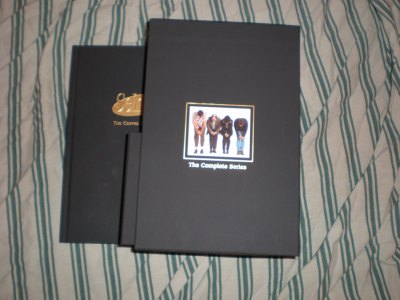
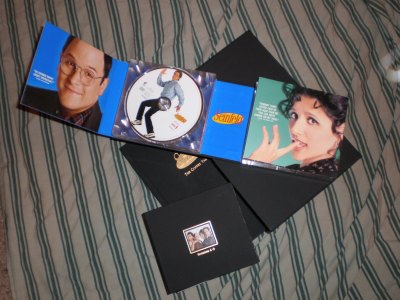
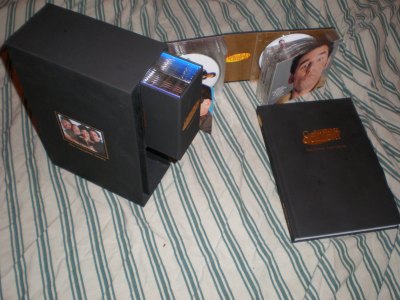
This is a good looking DVD package, befitting its high-end price. The quality of its design speaks to the respect the show has earned, giving it a permanent place of distinction in any collection it would be a part of.
Naturally, the seasons are put in the package in order, allowing for chronological repeat viewing. The individual DVDs have a "play all" function, or you can pick and choose from your favorite episodes. To help keep track, there is a four-sided, folded episode guide included that lists the order of the shows and what discs they appear on.
Season 1 (1990)
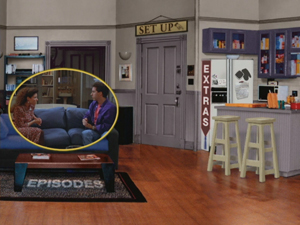
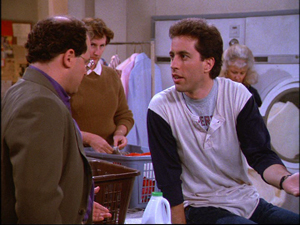
This short season of five episodes almost stands apart from the rest of the series. It's the testing ground for the show, the place where a lot of the bugs are worked out. The pilot in its original form even had a different title ("The Seinfeld Chronicles") and different music, as well as a character of a waitress at the local diner in place of Elaine (Julia Louis-Dreyfus), who doesn't show up until episode 2. The character of Kramer (Michael Richards) starts off as Kessler, and is more of a shut-in than a freewheeling eccentric. The idea of the series began as a high-concept thing, with Jerry's stand-up act relating as directly as possible to the story with the intention of showing how his real life inspired his comedy.
Even so, the basic focus on the minutia of relationships and the annoyances of everyday life is already apparent, and with each episode, the humor and structure gets a little sharper, edging its way toward what Seinfeld would ultimately become. By the fifth episode, "The Stock Tip," Seinfeld is hitting its groove.
EPISODES: * Pilot version 1 with original music/Pilot version 2 with updated music * Male Unbonding *The Stakeout (Jerry Seinfeld and Larry David) (featuring two takes of a vintage introduction by Seinfeld and Louis-Dreyfus) * The Robbery * The Stock Tip
[Titles in bold in the episode lists indicate an optional audio commentary, and the names following the title are the participants.]
Season 2 (1991)
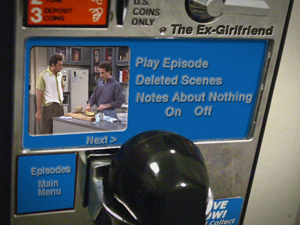
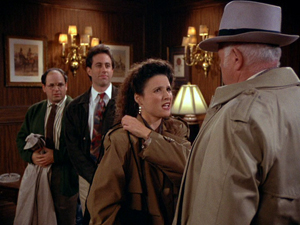
By the premiere of the second season, the kinks were gone and Seinfeld was secure in its cast and format. For me, the whole thing really becomes cemented in the sixth episode of the season, "The Chinese Restaurant." The daring real-time structure and the ability to wring every bit of humor out of a single situation in a single setting displayed how comfortable Larry David and Jerry Seinfeld were getting in the half-hour format. The fact that it lacks even a brief appearance by Kramer, who was the sitcom's breakout character, is also solid evidence of the overall strength of the show. Jerry, George (Jason Alexander), and Elaine stop at a Chinese place to get some dinner before a movie. Each is obsessed with his or her own problem, all of which vibrate to a fever pitch while the trio waits to be seated. George is trying to get his girlfriend of the moment on the phone to beg her forgiveness for an indiscretion, Jerry is worrying over ditching his Uncle Leo's dinner invitation to go out with his friends, and Elaine is hungry to such an extreme, it's practically become a psychosis. The hallmarks are all there: obsessiveness, inappropriate outbursts, relationship hang-ups both ridiculous and racy, and the sense that despite all of their neuroses, these characters are the only sane individuals in a world gone mad. Not as a unit, mind you. Jerry thinks George and Elaine are crazy, where he himself is fine. Likewise with Elaine. Maybe only George knows he's screwed up, but he still finds the rest of the population grating.
As for the remaining cast member, Kramer has two defining moments this season that told us more about who he was than any of the business that preceded them. The first is in the season premiere, "The Ex-Girlfriend," when he insists Jerry try the mangoes he bought at Joe's and refuses to let his neighbor continue to eat inferior fruit. Kramer's tastes for very specific things and his rigid standards would border on the fetishistic and much comedy would flow from his refusal to veer from these ideas. The second moment comes in "The Statue," when his disgust with a thief getting away with his crime inspires Kramer to get dressed up and go to the crook's apartment in the guise of an undercover cop. The manic, fast-talking performance was the kind of thing Michael Richards could effortlessly make his own, and it opened up the stage for the kinds of things Kramer was allowed to do, particularly once he set foot outside the apartment building.
EPISODES: * The Ex-Girlfriend * The Pony Remark * The Busboy (audio commentary with Julia Louis-Dreyfus, Jason Alexander, and Michael Richards) * The Baby Shower (writer Larry Charles) * The Jacket * The Chinese Restaurant * The Phone Message * The Apartment * The Stranded (featuring vintage introduction by Jerry Seinfeld) * The Statue * The Heart Attack (writer Larry Charles) * The Revenge (Julia Louis-Dreyfus, Jason Alexander, and Michael Richards) * The Deal (Jerry Seinfeld and Larry David)
Extras Seasons 1 and 2:
The first two seasons were originally packaged as one boxed set due to their shorter length. Because of this, they share bonus features, which are spread across all four discs. From disc to disc, the extras are specific to each episode, with the fourth DVD housing the overall extras: namely, an hour-long documentary called "How It Began," which features interviews with network executives, directors, writers, producers, and the cast. This excellent program covers the show's inception, its journey to the air, and its travails in the first year. Excerpts and expanded elements from this documentary are used on these and subsequent DVDs for "Inside Looks," mini-documentaries that are specific to an individual episode. These short bursts are wonderful, featuring great anecdotes but avoiding being overly long or repetitive. Plus, though they accompany the majority of the shows, they aren't on every single episode, and so if there is nothing to say, they don't waste time trying to contrive something.
In addition to audio commentaries on many episodes, they all have a "Notes About Nothing" feature, which is a subtitle trivia track.
There are deleted scenes, bloopers, and even excised jokes from the Seinfeld comedy routines for the show. Fans of Jerry's stand-up also get two of his appearances on "The Tonight Show"--his debut and his sitdown with Johnny Carson the night before his pilot aired. An additional "Tonight Show" segment shows Michael Richards playing a fake personal trainer with Jay Leno.
Finally, there are the original commercials from the early promotion of the series.
All of these extras can be accessed through a special features menu, or in the submenu for the episode they relate to. Please note, the introductions that play before some episodes can only be found on the special episode menu, as can the alternate version of the pilot. Most of the various things, such as the "Inside Looks" or deleted scenes, have a "play all" function.
Season 3 (1991-1992)
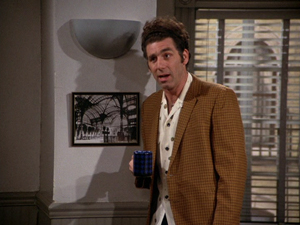
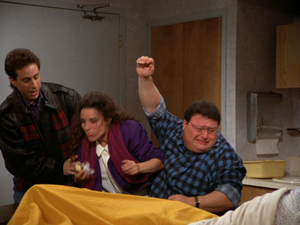
Season 3 is arguably the gold standard for Seinfeld. A good handful of the best-remembered episodes come out of the 1991-1992 run, and it's here that the writing solidified once and for all and Seinfeld had become everything it was supposed to be. It was also one of the higher-profile years as far as the cultural zeitgeist, introducing catchphrases like "These pretzels are making me thirsty" and "I have no hand" into the pop lexicon.
The greatest stride forward in Season 3 was in the ability of the crew to create stories that involved all four of the main cast, often on divergent paths that then converged in unexpected ways. For instance, in the episode "The Suicide," the team begins by being split in two halves. Jerry flirts with his next door neighbor's sexy European girlfriend, prompting a fight and the neighbor attempting to overdose on pills. Kramer needs his vacuum cleaner back from the neighbor, and he maintains a vigil over the man while he's in a coma, accompanied by downstairs tenant Newman (Wayne Knight, appearing for the first time). Jerry is afraid Newman will rat him out for the affair, and so he sticks to the pair like glue.
Meanwhile, George is planning a trip to the Bahamas, and Elaine is fasting while waiting to be tested for an ulcer. When she takes George to a psychic, the pregnant soothsayer warns him away from his vacation, but Elaine's testy outbursts get the two thrown out before George can find out why. George then accompanies Elaine to the hospital, discovering that the psychic is there giving birth. Jerry and Kramer are also there, and the various story lines become hopelessly entangled. Tying them all together? Drake's Coffee Cakes! The convolutions are nearly imperceptible, the comedy moves at a lightning pace.
Many of the stand-outs in this season also involved getting the gang out of their regular New York haunts. There is, of course, "The Pen," where Jerry and Elaine travel to Florida to visit Jerry's parents and get involved in some kerpuffle over an astronaut's pen. More importantly, though, are the episodes that take a cue from the great success of "The Chinese Restaurant" from Season 2 and try to put the crew in an enclosed space where they are subject to the absurdity of the environment. "The Parking Garage," for instance, where they are trapped looking for their car, wandering the many levels of the garage and getting into trouble. Also, "The Subway," which begins with all four of the guys on the same subway train, sees them split to various trains, and then follows the situations they get into on their own.
All the while, the team was getting more courageous and daring with material. Suicide, pregnancy scares, Nazism--nothing was off limits. Even surreal segments, like Jerry's penis playing chess with his brain in "The Nose Job" or the outright parody of JFK in "The Boyfriend." Whereas many series hit a pothole when they achieve a certain level of notoriety, feeling the pressure to live up to their new reputation, the makers of Seinfeld treated its growing popularity as fuel, only getting smarter and more outrageous, and constantly moving farther out on the ledge to see what they could get away with.
EPISODES: * The Note * The Truth * The Dog * The Library (audio commentary with writer Larry Charles) * The Pen (Jerry Seinfeld and Larry David) * The Parking Garage (director/producer Tom Cherones and production designer Tom Azzari) * The Café * The Tape * The Nose Job * The Alternate Side * The Red Dot * The Suicide * The Subway (Julia Louis-Dreyfus, Jason Alexander, and Michael Richards) * The Pez Dispenser (Jerry Seinfeld and Larry David) * The Boyfriend (Julia Louis-Dreyfus, Jason Alexander, and Michael Richards) (featuring vintage introduction by Jerry Seinfeld) * The Fix-Up * The Limo (writer Larry Charles) * The Good Samaritan * The Letter * The Parking Space (director/producer Tom Cherones and production designer Tom Azzari) * The Keys
Extras Season 3:
This set follows pretty much in line with the preceding box (they were released simultaneously), and together they establish a pattern of what extras are featured from box to box. They are: "Inside Looks" (short episode-specific documentaries), "Notes About Nothing" (subtitle trivia tracks), "In the Vault" (deleted scenes), "Not That There's Anything Wrong With That" (bloopers), "Master of His Domain" (outtakes from the Seinfeld stand-up), a photo gallery, and "Sponsored by Vandelay Industries" (original commercials).
Specific to the Season 3 collection is the documentary "Kramer vs. Kramer: Kenny to Cosmo," a look at the special talents of Michael Richards.
Season 4 (1992-1993)
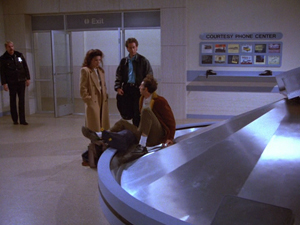
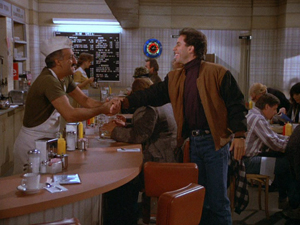
While previous seasons had some threads that ran through various episodes (George's job woes, Kramer's jacket, various girlfriends and love interests), Season 4 is the first to have a story line that becomes one of the major focal points of the entire season. That's right, this is the year that Jerry and George pitch their own network sitcom, a remarkably familiar show called "Jerry."
I love when entertainers peel back the curtain and show us the goings-on backstage, and I particularly love it when its television, because the tone is usually far more bitter and caustic than in any other medium. The Seinfeld gang is no less biting when it comes to gnawing on the peccadilloes of the network machine than they are with the idiosyncrasies of everyday life. From the two-part opener in Hollywood through the one-hour finale, "The Pilot," the writers have a blast working over the intricacies of the system. The executives are aloof and strange, completely disconnected from reality, while the actors are...well, less aloof, but still strange and completely disconnected from reality. (Watch for future stars Mariska Hargitay and Jeremy Piven auditioning for Elaine and George. In fact, I could do a whole tangent on actors who many saw for the first time on Seinfeld. This season alone had Teri Hatcher, Megan Mullally, Denise Richards, and Jane Leeves.)
Having these particular episodes on DVD, complete with the usual batch of extras, takes yet another hammer to the fourth wall. Having been watching all the supplements as I've gone through each disc, by the time I got to Season 4, many of the anecdotes and the people featured were already familiar to me. The truth and the fiction is so twisted and bent, there is no longer any sense in separating one from the other.
Smartly, the show creators didn't let this story take over the entire season. Though there was a greater cohesion over these 22 episodes--the Joe Davola stalkings, Morty Seinfeld's wallet, George's mom in and out of the hospital--the meat and potatoes were still best in the individual helpings. Season 4 gave us several more quintessential Seinfeld episodes, including "The Smelly Car," "The Airport" (another labyrinthine script about being trapped in a particular place), and perhaps the most notorious of all, "The Contest." "The Contest" is a must-see example of how far modern television can really go. The bet between the four friends to see who could abstain from masturbating the longest is one of the funniest things ever to be put on television, spawning multiple catchphrases through its many ways around saying what the show was actually about. Who doesn't know what it means to be "master of your domain"?
EPISODES: * The Trip: Part 1 (audio commentary with writer Larry Charles) * The Trip: Part 2 (writer Larry Charles) * The Pitch / The Ticket * The Wallet * The Watch * The Bubble Boy * The Cheever Letters (Julia Louis-Dreyfus, Jason Alexander, and Michael Richards) * The Opera * The Virgin * The Contest (Jerry Seinfeld) * The Airport (writer Larry Charles) * The Pick * The Movie * The Visa * The Shoes * The Outing (Julia Louis-Dreyfus, Jason Alexander, and Michael Richards) * The Old Man * The Implant (writer Peter Mehlman) * The Junior Mint (Jerry Seinfeld) * The Smelly Car * The Handicap Spot original version/The Handicap Spot syndication version with Jerry Stilller (including a new introduction by Jason Alexander) * The Pilot: Part 1 & Part 2 (production designer Tom Azzori and director/producer Tom Cherones)
Extras Season 4:
Once again, we get all of the following: "Inside Looks" (short episode-specific documentaries), "Notes About Nothing" (subtitle trivia tracks), "In the Vault" (deleted scenes), "Not That There's Anything Wrong With That" (bloopers), "Master of His Domain" (outtakes from the Seinfeld stand-up), a photo gallery, and "Sponsored by Vandelay Industries" (original commercials).
The documentary featured for this set of shows is "The Breakthrough Season," which talks about the sitcom's newfound success moving into the timeslot after Cheers, priming it for the pole position when that series ended. The "Jerry" plot device and the episode "The Contest" are also covered, cited as two major elements for garnering the show more attention.
In addition to the regular collection of commercials for this season, the special promos that the show made for the 1992 Summer Olympics are also included. Finally, we get a segment of "Live with Regis and Kathie Lee" where the morning yackers talk about Seinfeld, and a parody of that segment made by the cast of the show.
Season 5 (1993-1994)
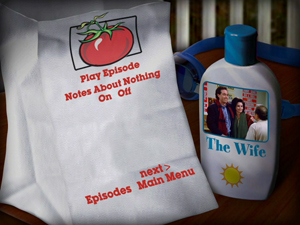
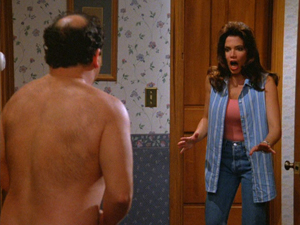
With "Jerry" already cancelled, it's back to business as usual on Seinfeld. In fact, the premiere episode, "The Mango," would get jaws immediately wagging with its frank discussion of the female orgasm and Elaine's admission that she's been known to fake it. Insecurities boil over for both George and Jerry. And remember that fruit stand Kramer talked about back in Season 2? It returns here when Kramer's pickiness over his fruit gets him banned from the store.
New writers joined the staff for Season 5, and though the shift was to more episode-based comedy, they did take on a more "anything goes" bend. This is a sort of natural shift that often has to happen in a long-running sitcom when more grounded plots begin to become harder to come by. Thus, we can get the gang wrapped up in a non-fat yogurt scandal that effects the New York mayoral election or in an operatic drama with a pair of barbers in love with Jerry's lustrous mane.
It doesn't always work. There was some stumbling on the way to figuring out what the right mix was. Some of the episodes go too far into the absurd. George and Kramer rock climbing in "The Stall" comes off as cheesy, and the swirling narrative of "The Marine Biologist" loses control. In that second act, when they try to move quickly and weave all the plot lines together, the comedy loses some of its potency. Having Kramer drop a shoe out of the window and landing on Newman comes out of nowhere and causes the episode to flatline. There was no need to tie either of those characters into the Jerry and Elaine story line of having portable electronic devices tossed from windows and hitting a bystander (Carol Kane). Newman isn't even in the rest of the episode! Only Jason Alexander's masterful final monologue about rescuing a whale pulls this particular episode out of freefall.
When Season 5 is on point, though, it really hits in every manner. The final disc of the season is one of the most perfect of the set. Beginning with "The Wife," the show where Jerry and Courtney Cox pretend to be married to get a dry-cleaning discount, and ending with "The Opposite," when George turns his life around by doing the exact opposite of what his instincts tell him to do, DVD 4 has five episodes of sheer comedy heaven. Morty Seinfeld and Kramer try to go into business selling raincoats together, George lies to get out of the Big Brothers program and also must deal with the consequences of "shrinkage," and Jerry gets caught making out during Schindler's List. Every show is hilarious. Seinfeld was riding high at this point, both creatively and in the ratings.
EPISODES: * The Mango (audio commentary by Michael Richards, Julia Louis-Dreyfus, Jason Alexander) * The Glasses (writers Tom Gammill and Max Pross) * The Puffy Shirt * The Sniffing Accountant * The Bris * The Lip Reader (writers Peter Mehlman and Carol Leifer) * The Non-Fat Yogurt original Mayor Giuliani version/The Non-Fat Yogurt alternate Mayor Dinkins version * The Barber * The Masseuse * The Cigar Store Indian (writers Tom Gammill and Max Pross) * The Conversion * The Stall * The Dinner Party * The Marine Biologist (director/producer Tom Cherones and production designer Tom Azzari) * The Pie (writers Tom Gammill and Max Pross) * The Stand-In * The Wife * The Raincoats (parts 1 and 2) * The Fire * The Hamptons (writers Peter Mehlman and Carol Leifer) * The Opposite (Jerry Seinfeld and Larry David)
Extras Season 5:
Once again, we get all of the following: "Inside Looks" (short episode-specific documentaries), "Notes About Nothing" (subtitle trivia tracks), "In the Vault" (deleted scenes), "Not That There's Anything Wrong With That" (bloopers), "Master of His Domain" (outtakes from the Seinfeld stand-up), and "Sponsored by Vandelay Industries" (original commercials).
"Jason + Larry = George" is a half-hour documentary exploring what both Larry David and Jason Alexander put into the George character. Though there is some recycling of material from the first volume's documentary, there are added show writers who provide commentary for the first time and a sit-down between Jason and Larry that ends in shtick.
Season 6 (1994-1995)
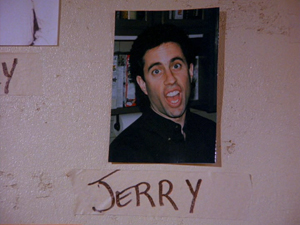
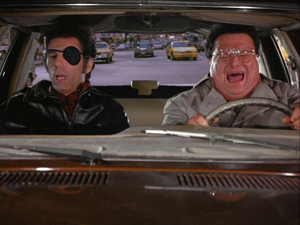
At this point, it becomes a little harder to gauge the evolution of the show. With Seinfeld this well nestled in its slot at the top of the TV game, it all becomes rather subjective what is anyone's favorite or least favorite run. I actually think Season 6 is a real high point, getting comfortable with the wilder story lines that had emerged in the previous year and managing to build more solid scripts around them. I think by accepting that the show could go as far as it wanted afforded the writers a certain level of freedom. Thus, there are still episodes that revolve around individual quirks, such as "The Jimmy" where a guy named Jimmy refers to himself in the third person. Yet, next to that, we get Kramer being mistaken for a mentally challenged adult and serenaded by Mel Torme.
Long-running plots in Season 6 include George's ups and downs as a working member of the Yankees organization and his returning independence marred by the separation of his parents, which caused his father to move in with him. This, of course, culminated in "The Fusilli Jerry," when the plans for Frank Costanza and Kramer's invention of the male bra went up in smoke once and for all, with Kramer "stopping short" and Frank hitting that million-to-one shot. Elsewhere, Elaine spends most of the year working for Mr. Pitt (Ian Abercrombie) but ends up meeting J. Peterman (John O'Hurley) for the first time, as well. Likewise, she also has her first period of dating David Puddy (Patrick Warburton), the odd mechanic who plays as some kind of macho antidote to Jerry.
There is also Jerry's continued rivalry with Newman, and the introduction of a new foe, Kenny Bania (Steve Hytner). George buys Jon Voight's car, Poppie (Reni Santoni) pees on Jerry's couch, and Kramer has both his first name revealed at last and meets his idol, Bette Midler. Just to name a few of the more memorable things that happened in Season 6. Every episode has at least one plot thread or concept that became part of the pop culture lexicon. Most shows are lucky to have one a season, but the Seinfeld team was getting it every time out.
EPISODES: * The Chaperone * The Big Salad * The Pledge Drive * The Chinese Woman * The Couch * The Gymnast (Jerry Seinfeld, director Andy Ackerman, and writers Alec Berg and Jeff Schaffer) * The Mom & Pop Store (writers Tom Gammill and Max Pross) * The Soup * The Secretary * The Switch * The Race (Jerry Seinfeld and director Andy Ackerman) * The Label Maker (writers Alec Berg and Jeff Schaffer) * The Scofflaw * Highlights of 100 (parts 1 and 2) * The Beard (Jason Alexander and Julia Louis-Dreyfus) * The Kiss Hello * The Doorman (writers Tom Gammill and Max Pross) * The Jimmy * The Doodle * The Fusilli Jerry (Jason Alexander and Julia Louis-Dreyfus) * The Diplomat's Club (writers Tom Gammill and Max Pross) * The Face Painter * The Understudy
Extras Season 6:
The format remains the same for the most part: "Inside Looks" (short episode-specific documentaries), "Notes About Nothing" (subtitle trivia tracks), "In the Vault" (deleted scenes), "Not That There's Anything Wrong With That" (bloopers), and "Master of His Domain" (outtakes from the Seinfeld stand-up). For the first time, the original commercials section, "Sponsored by Vandelay Industries," is dropped from the roster.
"Running with the Egg: Making a Seinfeld" is a two-part documentary, running thirty-three minutes, that goes through the process of putting the show together, from pitch to completion. It would have been more interesting had they been able to focus on one particular episode, but there is still some good insight into the creative process--though at this point, some of the clips of various crew and cast members are ones we've seen before.
The one new addition to the roster of extras is "Sein-Imation." These are short cartoons taking dialogue heavy scenes from the show and animating them. The shorts are pretty funny, and the scenes picked are smart ones. The idea is to take a bit where someone tells a story that was not filmed in live-action and to show that story in an exaggerated cartoon form. For instance, the scene in "The Face Painter" where Kramer describes his first encounter with the chimpanzee who throws a banana peel at him. In the episode, we don't see the altercation, but in the "Sein-Imation," when Kramer describes it, we get images of the scuffle to go with the dialogue.
Season 7 (1995-1996)
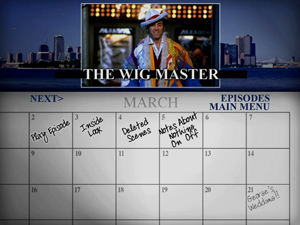
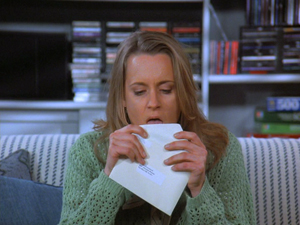
I remember by the time that the seventh season of Seinfeld had ended, some critics were complaining that the show had gotten too dark. By the finale, "The Invitations," they thought the characters had turned a corner and there was no coming back. Human life had no value, death was just another punchline.
Not that there is anything wrong with that. With Larry David at the helm, this shift in tone was not just a whim. The idea is put on the table in the opening episode, "The Engagement." In a rare moment of self-awareness, Jerry begins to question his life. Is it enough to go through a string of women, never staying with one for long, never committing to anything? He and George make a pact to get serious about their lives, to grow up and look to the future. Of course, this plan goes awry. Kramer quickly talks Jerry out of giving up his freedom for the prison of a stable life, but no one stops George from running off to find Susan Ross and asking her to marry him.
Seinfeld spent its first six seasons tearing into the rest of the populace for its idiosyncrasies and what the core cast saw as faults. In Season 6's "The Face Painter," Elaine says to Jerry, "I will never understand people," and he replies, "They're the worst." This is Seinfeld summed up in two lines. Though we have been laughing all along, we've largely been laughing with Jerry, Elaine, George, and Kramer. In Season 7, Larry David decides that we should be laughing at them. Now all of their obsessions and peculiar ideas will be seen as their downfall. Jerry's reasons for dumping his girlfriends will grow more and more ridiculous, and though Elaine will also make claims to wanting a better life, her need to judge men on whether or not they are "sponge-worthy" makes her as updateable as Jerry.
Susan Ross ends up providing the main counterpoint against the Seinfeld-centered world. In "The Pool Guy," George begins to disintegrate when Elaine tries to bring Susan in the circle. George points out that there are now two of him: Independent George and Relationship George. If the two ever meet, he fears that Relationship George will devour the Independent version, who gets to do all the things that relationships usually put a stop to. What George doesn't count on is that Susan will find that independent world as crass and would rather stay out of it than interrupt it.
Many of the stories will feature George trying to navigate these two worlds, and when he does, it sheds more of a light on the others. The nature of secrets and shared information, for instance, are subjects of both "The Secret Code" and "The Sponge." Plus, there is the disastrous meeting of the in-laws in "The Rye."
Not that Season 7 is only about George's engagement, even if it does take us from the premiere to the finale. We get more outrageous schemes, like kidnapping the dog that annoys Elaine by barking through the night, as well as Newman and Kramer trying to make a fortune from bottle deposits. We meet the Soup Nazi, homosexual thugs who terrorize Kramer, and a creepy doll who looks like Estelle Costanza. Even if the flavor is a little more bitter this year, it's still plenty hilarious.
It was also to be Larry David's last season. Would we have wanted him to leave under any less shocking circumstances?
EPISODES: * The Engagement * The Postponement (Audio commentary by Jason Alexander and Julia Louis-Dreyfus) * The Maestro * The Wink * The Hot Tub * The Soup Nazi (Jerry Seinfeld, director Andy Ackerman, and writer Spike Fersten) * The Secret Code (writers Alec Berg and Jeff Schaffer) * The Pool Guy (Jerry Seinfeld, Andy Ackerman, and writer David Mandel) * The Sponge (writer Peter Mehlman) * The Gum (writers Tom Gammill and Max Pross) * The Rye * The Caddy * The Seven * The Cadillac, Parts 1 & 2 * The Shower Head (Jason Alexander and Julia Louis-Dreyfus) * The Doll (writers Tom Gammill and Max Pross) * The Friars Club (writer Dave Mandel) * The Wig Master * The Calzone (Jerry Seinfeld, Andy Ackerman, writers Berg and Schaffer) * The Bottle Deposit, Parts 1 & 2 * The Wait Out * The Invitations
Extras Season 7:
"Inside Looks" (short episode-specific documentaries), "Notes About Nothing" (subtitle trivia tracks), "In the Vault" (deleted scenes), "Not That There's Anything Wrong With That" (bloopers), "Master of His Domain" (outtakes from the Seinfeld stand-up), a photo gallery, and "Sein-Imation."
The documentary "Queen of Her Castle: The Elaine Benes Story" is a long overdue, sixteen-minute tribute to the character and the woman who plays her.
Two other documentaries pay tribute to Larry David. The near eight-minute "Larry David's Farewell" gives the show's twisted pappy a proper send-off, where the seven-minute "Where's Larry?: Seinfeld Secret Guest Star" compiles the various appearances of Larry David over the years, either as a voice or on camera.
Season 8 (1996-1997)
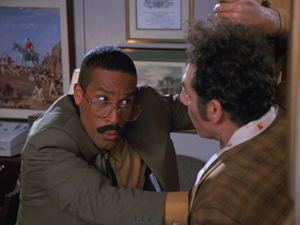
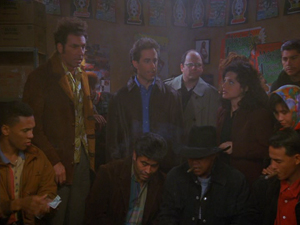
If my memory serves, popular opinion was that Seinfeld was not "as good" when Larry David left. I know in my mind I had always thought the last couple of years were not up to snuff by comparison, but looking at the episodes Season 8 is made up of, I realize that I didn't necessarily have a clear delineation in my head of what that season actually was. On the first disc alone are shows I consider as classics, including "The Bizarro Jerry," Elaine's dancefloor disaster "The Little Kicks," and Kramer's poultry problem in "The Chicken Roaster." I had also forgotten completely about "The Abstinence," the episode where George discovers that foregoing sex makes his brain sharper, and then when Elaine tries abstaining, she actually gets dumber. I'd put that episode up with any of the best from previous years.
If there is any noticeable difference in Season 8, it's that Seinfeld takes itself a lot less seriously. There is a new abandon to the writing and performing. Nothing that they do is that far afield from what had been done before. The Apocalypse Now parody with Peterman is no more outrageous than the old Midnight Cowboy send-up with Kramer and Jerry, nor are any of the relationship hang-ups any more ridiculous. If anything, there is a greater freedom to call these hang-ups ridiculous, and Jerry in particular becomes a broader target. His germophobia gets more heightened, leading to the toothbrush falling in the toilet in "The Pothole." He is so freaked out that his girlfriend (Kristin Davis) cleaned her teeth with an instrument that touched toilet water, he can't bring himself to kiss her. Her revenge on him for this is ingenious, causing even Jerry to question his own sanity. Point of fact, Seinfeld deserves some props not just for his increased role in the writing this year, but also for being willing to push himself as an actor. His impersonation of Kramer in "The Chicken Roaster" had me in stitches. (Due to his increased responsibility, Jerry dropped the stand-up bumpers from the show once and for all, since they took up too much time.)
The final disc of the season yet again has a handful of memorable episodes, including Elaine's scheme for a store that only sells muffin tops and the various plots that intertwine in "The Yada Yada." As much as people fixated on the "yada yada" phrase, I actually found the whole bit with Tim Whatley (Bryan Cranston) changing religions in order to get full joke immunity to be the real winning story line. Season 8 rings out with "The Summer of George," wherein Kramer and Elaine are in symmetrical story lines about dangerous women (played by Molly Shannon and Raquel Welch, as herself) who don't swing their arms, and George ends up in the hospital due to a greeting card mishap, putting himself right where he sent Susan at the end of Season 7.
EPISODES: * The Foundation * * The Bizarro Jerry (audio commentary by writer David Mandel) * The Little Kicks (Julia Louis-Dreyfus, Jason Alexander, and writer Spike Feresten) * The Fatigues (writers Gregg Kavet and Andy Robin) * The Checks (writers/producers Tom Gammell and Max Pross) * The Chicken Roaster (two commentaries: writers Jeff Schaffer and Alec Berg; Jerry Seinfeld and director Andy Ackerman) * The Abstinence (Jerry Seinfeld, Andy Ackerman, and writer Steve Koren) * The Comeback (Andy Robin and Gregg Kavet) * The Susie (David Mandel) * The Pothole (Jerry Seinfeld, Andy Ackerman, and director/writer Dan O'Keefe) * The Nap (Andy Robin and Gregg Kavet) * The Yada Yada (Julia Louis-Dreyfus, Jason Alexander, and producer/writer Peter Mehlman) * The Muffin Tops (Julia Louis-Dreyfus, Jason Alexander, and Spike Feresten) * The Summer of George (Alec Berg and Jeff Schaffer)
Extras Season 8:
"Inside Looks" (short episode-specific documentaries), "Notes About Nothing" (subtitle trivia tracks), "In the Vault" (deleted scenes), "Not That There's Anything Wrong With That" (bloopers), and "Sein-Imation."
A twenty-four minute piece, "Jerry Seinfeld: Submarine Captain," focuses the camera lens on the main man, the make-up of his personal character, and how it led to the show's success. This is done almost entirely with the testimony of others, with Seinfeld barely chiming in at all. We also get a funny clip of him presenting an award at the Emmys. I found the theory that, in any given scene, the rest of the cast is the set-up of the joke while Jerry is the punchline to be particularly insightful. It's one of those ideas you hear and immediately think, "Oh, yes, that makes so much sense."
Season 9 (1997-1998)
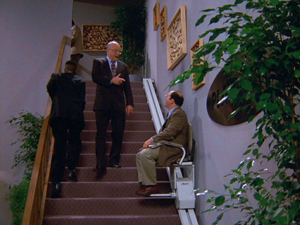
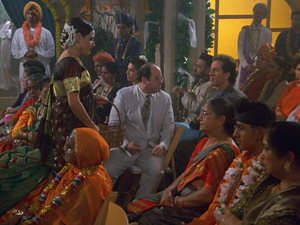
The pressure was on for this last season to make it special. Everyone was watching, and the staff was constantly expected to up the ante. For the most part, it was business as usual, with more classic episodes such as "The Serenity Now" and "The Strike," which introduced Festivus to the world. There were some format-breaking shows, including "The Betrayal," which channeled Harold Pinter and told the story completely in reverse, and "The Merv Griffin Show," where Jerry's apartment was never even shown. Also, more episodes taking advantage of enclosed spaces/environments, like the car-centric "The Dealership." Jerry goes to buy a car, George gets his candy bar stolen, and Kramer takes an extended test drive.
In a way, there were two finales to the season. The first is the penultimate episode. "The Puerto Rican Day" was the last to be written by the writing staff before Larry David's return to put the fork in Seinfeld. Sadly, this very funny episode has been out of circulation due to some controversy surrounding Kramer accidentally setting fire to a Puerto Rican flag. It's too bad, because it's another hysterical trek through an impossible situation. Cut off from their homes by the Puerto Rican Day parade, the gang takes advantage of their confinement in different ways. Elaine tries to escape, George gets chased by a jerk with a laser pointer, Kramer dives into the festivities, and Jerry gets locked into a battle of wills with another driver (Mario Joyner).
"The Puerto Rican Day" is followed by the double-length "The Chronicles," a clip show that ran before the extended send-off, "The Finale." Written by Larry David, "The Finale" is the unfairly maligned bow on top of the Seinfeld package. How to finish a nine-year series is a near-impossible challenge, especially when the show was so popular and there was no over-arching story line that could signal the way for the exit. It's very nearly a no-win situation. Expectations are too high, and you can't please everyone.
Conceptually, Larry David found a winning premise. In the wake of Princess Diana's tragic death and the paparazzi who didn't lend a hand to help, the French government passed a "Good Samaritan law." In essence, if you saw someone in trouble and did nothing to aid them, you could be held responsible by law. Hearing this, David knew there was no way his fictional avatars would ever survive if such a law would be enacted in America, and so he contrived for them to run afoul of just such legislation in a small Massachusetts town. On trial for videotaping an obese man being carjacked and cracking jokes at his expense, a parade of characters from the nine years of the sitcom stroll into court to testify that there has been an ongoing pattern of indifference and abuse perpetrated by "the New York Four."
This trial idea allows the show to revisit some of its top moments, providing a way to sum up the nine seasons it was on the air. It also creates a way to send the characters on their way that is not only big, but different than everything they had done before. A regular episode would not have suited anyone, and with the "no hugging, no learning" policy, there was no chance of a feel-good farewell. In fact, what makes this last show funny is how staunchly they hold to that policy. The failure of Jerry, Elaine, George, and Kramer to even recognize the gravity of their situation or their own meanness is what really makes "The Finale" funny. Would we have really wanted them to cave in and become normal members of society at the end? Would we have accepted a wedding, or even career success? It seems to me it was either prison or death.
EPISODES: * The Butter Shave * The Voice (audio commentary by writers Jeff Schaffer, Alec Berg, and David Mandel) * The Serenity Now (writer Steve Koren) * The Blood * The Junk Mail * The Merv Griffin Show (Julia Louis-Dreyfus, Jason Alexander, director Andy Ackerman, and writer Bruce Eric Kaplan) * The Slicer (writers Greg Kavet, Andy Robin, and Darin Henry) * The Betrayal/The Betrayal played in "proper" order (writers David Mandel and Peter Mehlman) * The Apology * The Strike (Jerry Seinfeld, Andy Ackerman, and writer Dan O'Keefe) * The Dealership (Julia Louis-Dreyfus, Jason Alexander, Patrick Warburton, and director Andy Ackerman) * The Reverse Peephole > (Julia Louis-Dreyfus, Jason Alexander, Patrick Warburton, and writer/producer Spike Fereston) * The Cartoon * The Strongbox * The Wizard * The Burning (Julia Louis-Dreyfus, Jason Alexander, Patrick Warburton, and director Andy Ackerman) * The Bookstore * The Frogger * The Maid (Alec Berg, Jeff Schaffer, and David Mandel) * The Puerto Rican Day (Steve Koren and David Mandel) * The Chronicle (Parts 1 & 2) (with second introduction for the syndicated part 2) * The Finale (Parts 1 & 2)
Extras Season 9:
"Inside Looks" (short episode-specific documentaries), "Notes About Nothing" (subtitle trivia tracks), "In the Vault" (deleted scenes), "Not That There's Anything Wrong With That" (bloopers), and "Sein-Imation."
"The Last Lap" is a twenty-three minute show about the decision to end the series when they did and the filming of the last episode, from the heightened security around the script and the taping to the fiercely negative reaction to the episode. There are outtakes from the finale, but also clips from it. Given that this appears on the first disc of Season 9, you may want to consider holding this documentary until the end.
On DVD 4, "Scenes from the Roundtable" is eighteen minutes of outtakes (with a slight repeat of material) from the special discussion between Seinfeld, Louis-Dreyfus, Alexander, Richards, and Larry David that runs in full on the extra disc exclusive only to this set (see below). There is also a preview for Spider-Man 3 on the last disc, because I guess Sony forgot that Jerry is into Superman.
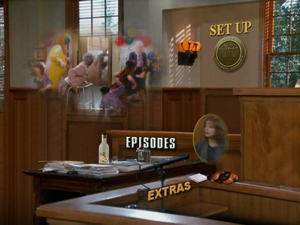
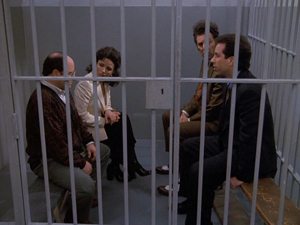
THE DVDs
Video:
Seinfeld was shot in full frame (1.33:1). The sources used for the DVDs are the original NBC versions and not faded syndication prints. This means that the colors are more vibrant and free of any hiccups you're likely to see on the nightly airings on your local TV station. The discs are all formatted the same, with "play all" functions along with submenus for each episode. There are no egregious or persistent problems. On the contrary, the sets are all really well done. You may notice occasional pauses in the shifts between shows or even sometimes between scenes, but that's the closest I found to something to complain about.
Sound:
A stereo mix (Dolby Digital) of the original English soundtrack is solid, with good volume levels and a clean background. There is also a French audio track, and four subtitle options on all the episodes: English, French, Portuguese, and Spanish. These subtitles choices also apply to "Notes About Nothing."
Additionally, there is Closed Captioning.
Extras:
Please see the sections for the individual seasons for the specific extras for each year. These special features are all carry-overs from the earlier sets, and they include a variety of Easter Eggs. Please check the DVD Talk Easter Egg Database to get more information on how to find these hidden features. (You can also do a review search on the site for "Seinfeld" to see what our other reviewers had to say on a season-by-season basis.) I found one egg on the last disc of Season 9. In the submenu for the "finale" episode, keep pressing your down arrow until the fingerprint is highlighted. Select it, and you will see the alternate verdict, likely shot so no one would know which way the story would go.
The Complete Collection does have one bonus not available in any other set, the extra disc nestled in the back of The Coffee Table Book. This DVD has an hour-long, two-part program called "The Roundtable: The Cast of Seinfeld and Larry David." Just as it sounds, it's a sitdown with Larry David, Jerry Seinfeld, Jason Alexander, Julia Louis-Dreyfus, and Michael Richards. It's the first time they've gathered in front of cameras in the nine years since the series ended, and they reminisce about the show, looking at clips and talking about working together. It's a jovial discussion, full of laughter, and it shows a little of what it must have been like on set. Surprisingly, as with all the extra interviews, Michael Richards is the most sober member of the cast. (For those wondering, no, his unfortunate incident at a comedy club last year is not brought up. Which is fine by me, that's not what this is about.)
FINAL THOUGHTS:
I have to say, even if this wasn't such a great set, watching Seinfeld - The Complete Collection again was a real treat. Reliving each episode in order, front to back, pilot to finale, proved that the show's enduring reputation was not lightly earned. I was impressed by how consistently hilarious the sitcom was for its nine-year, 179-episode run. I was also surprised to see how organic the whole thing was, growing from one episode to the next, little germs in one show becoming a full-blown disease many episodes later. Seinfeld stayed true to itself, dodging the pitfalls of success and outside influence, letting all involved grow so that the series itself continued to progress and improve just like a living being. The Complete Collection is a fancy package and no less a tribute than Seinfeld deserves. The overall construction of the DVDs is unified, so it works as one big set, and the new extras exclusive to The Complete Collection only add value to the whole. This is the top, the reason the DVD Talk Collector Series classification was invented.
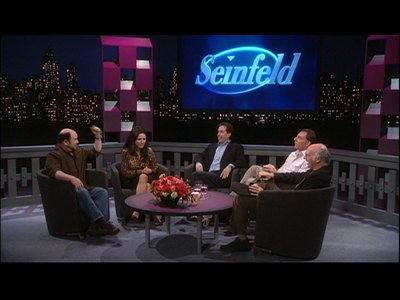
Jamie S. Rich is a novelist and comic book writer. He is best known for his collaborations with Joelle Jones, including the hardboiled crime comic book You Have Killed Me, the challenging romance 12 Reasons Why I Love Her, and the 2007 prose novel Have You Seen the Horizon Lately?, for which Jones did the cover. All three were published by Oni Press. His most recent projects include the futuristic romance A Boy and a Girl with Natalie Nourigat; Archer Coe and the Thousand Natural Shocks, a loopy crime tale drawn by Dan Christensen; and the horror miniseries Madame Frankenstein, a collaboration with Megan Levens. Follow Rich's blog at Confessions123.com.
|
| Popular Reviews |
| Sponsored Links |
|
|
| Sponsored Links |
|
|
| Release List | Reviews | Shop | Newsletter | Forum | DVD Giveaways | Blu-Ray | Advertise |
|
Copyright 2024 DVDTalk.com All Rights Reserved. Legal Info, Privacy Policy, Terms of Use,
Manage Preferences,
Your Privacy Choices | |||||||









